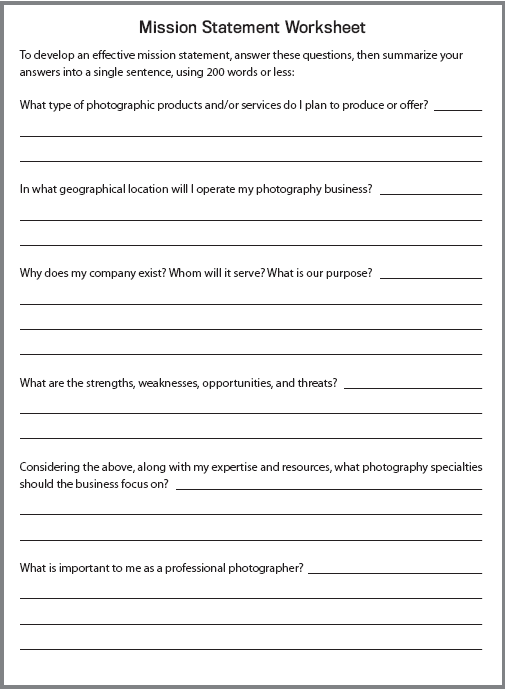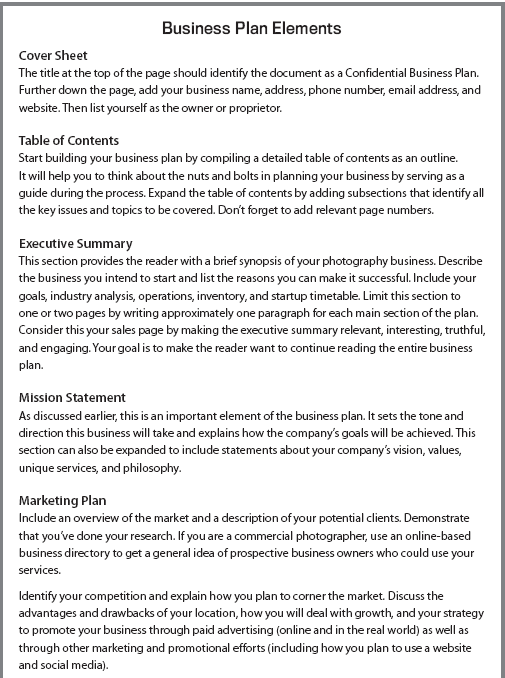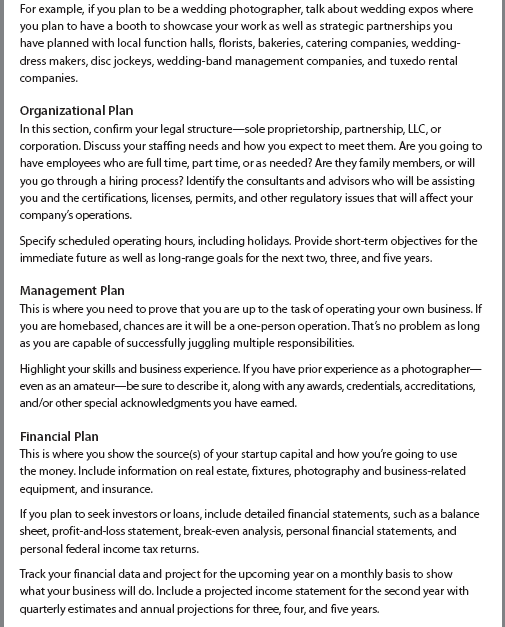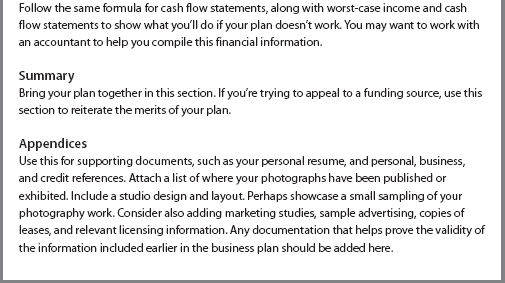
Focusing on the Right Path
CHAPTER
5
|
Focusing on the Right Path |
Running your own photography business can be great fun, but it’s about more than taking pictures and scouting locations for shoots. It also involves the nuts-and-bolts aspects of starting and running a legitimate business. One of the first steps involved in starting any new business is to develop a well-thought-out business plan. This can become your blueprint or roadmap for success. While a formal business plan is often used to help a startup recruit investors, as a small-business operator, you can create a business plan that simply allows you to outline and fine-tune your ideas. The process of composing a business plan and compiling the information to include within it forces you to think about all aspects of the business and will later help you stay focused.
You might think that the process of writing a formal business plan is a time-consuming and daunting task. However, it doesn’t have to be, especially if you’re not seeking investors or loans from a bank.
First, invest in some business plan creation software (or subscribe to an online-based business plan creation service), such as LivePlan (www.liveplan.com), Business Plan Pro (www.businessplanpro.com), or Growthink (https://strategicplantemplate.growthink.com). Any of these easy-to-use applications will walk you, step by step, through the business plan creation process. Or check out Write Your Business Plan (Entrepreneur Press, 2016) or Start Your Own Business (Entrepreneur Press, 2018).
Another option is to download a free business plan template from the SBA (www.sba.gov/business-guide/plan-your-business/write-your-business-plan) and use it to help gather your ideas, dreams, and goals and shape them into what will hopefully become the plan for a well-structured and eventually profitable business.
Writing a business plan forces you to sit down and consider a range of areas:
▶ Examining the financial aspects related to your business idea.
▶ Analyzing the potential risks.
▶ Formulating and fine-tune your goals and vision.
▶ Determining your strengths as a photographer and business professional.
▶ Pinpointing your weaknesses and what skills you still need to develop.
▶ Anticipating the challenges you’ll face.
▶ Figuring out what types of assistance you’ll need.
▶ Choosing your photography specialty.
▶ Analyzing your competition.
▶ Considering who your target audience (potential customers/clients) will be.
▶ Creating a step-by-step game plan for getting the business set up as a legal entity, then operational in a realistic time frame.
▶ Developing a marketing, advertising, and promotions strategy based on your goals, time constraints, and budget.
Working through the process of creating a business plan helps you ask some of the hard questions about how you are going to make your photography dreams a reality.
Be a Fan of the Plan
If you’re excited about your business, creating a business plan should be an exciting process, not a painful one. It will help you define and evaluate the overall feasibility of your concept, clarify your goals, and determine what you’ll need for startup and long-term operations.
Once your business plan is created, it will serve as a detailed roadmap for the formation and operation of your company. You’ll use it as a guide, referring to it regularly as you work through the startup process, then during your day-to-day business-related activities. And if you need to seek outside financing, either in the form of loans or investors, your business plan will be the tool that helps convince funding sources that you are worth every penny.
Putting together a business plan is not a linear process, although the final product may look that way. Take your time developing your plan. This is a very important first step in establishing what needs to become a strong foundation for your business.

warning
When you make a change to one part of your business plan, be sure you think through how that change will impact the rest of your operation. For example, if you start out working exclusively in a studio doing only portraitures but later decide to go out on location to shoot weddings and other events, you have to change your equipment needs, your scheduling plans, and your projected income as well as your marketing, advertising, and promotional plans.
After all, shooting weddings means you will be working on weekends, and you’ll need to adopt different methods for finding and landing clients, compared to running a photo studio where people come to you for portraits.
Start with a Clear Mission Statement
A mission statement is an important part of your business plan. In just a sentence or two, it needs to summarize your business and its objectives in a clear and concise way. As the business operator, you must develop a crystal-clear understanding of what the mission of your company will be. Your mission statement should answer these questions:
▶ What will you be doing and why?
▶ How and where will your business be conducted?
▶ Who will be your clientele?
▶ What will be unique about your business and its services?
▶ What will be your corporate philosophy, and why should people care?
Even if you have already started your photography business, it’s not too late to write your mission statement. This helps everyone involved see the big picture and stay focused on the true goals of the business. At a minimum, your mission statement should define who your primary customers are, identify the products and services you provide, and describe the geographical area(s) where you’ll operate.

aha!
Your company’s mission statement will be a big help when it comes to brainstorming an attention-getting advertising or marketing slogan that you can prominently place in a range of areas: your advertising and marketing materials, your website, your company’s social media profiles, or your business cards and letterhead.
For example, your mission statement might state, “The mission of ABC Photography is to provide top-quality commercial photography, at a fair and reasonable price in the Raleigh/Durham area, while assuring that our clients will receive the highest level of attention, commitment, and professionalism.”
Your mission statement should be short—usually just one sentence and certainly no more than two or three. Anything longer isn’t a mission statement and may be too convoluted and hard to memorize. Your mission statement also doesn’t have to be clever or catchy—just accurate. Don’t make grandiose statements that you have no ability to achieve or create expectations that you can’t or will not be able to live up to. The Mission Statement Worksheet will help you get a jump start on writing it (see Figure 5–1 on page 49).
Once you’ve articulated your message, communicate it as often as possible to employees, customers, suppliers, and potential investors and lenders.
Time to Write the Plan
Once you’ve identified the products and services you want to offer and to whom and you have created a mission statement, you’re ready to work on your business plan.
Though the specific content of your business plan will be as unique as the photography niche you choose, there is a basic format it should follow. The format ensures that you address all the issues you need to as well as provide lenders (and potential investors) with a comprehensive document that’s organized in a familiar way.
Using text, as well as charts, tables, and perhaps a few photographs to demonstrate key points, the main parts of your business plan should include the components covered in Figure 5–2, Business Plan Elements, starting on page 50.
Nobody likes to admit their personal or professional shortcomings. However, your business plan should identify any weaknesses and, more important, describe how you plan to overcome them. For instance, if you’re a great photographer but your photo editing and image enhancement skills are lacking, discuss how you’re enrolled in an Adobe Certification program for Photoshop and/or Lightroom (www.adobe.com/training/certification.html), for example.

FIGURE 5–1: Mission Statement Worksheet



FIGURE 5–2: Business Plan Elements
When you think your business plan is complete, look at it with a fresh eye. Is it a true and honest representation of the facts? Is it realistic? Does it consider all the possible variables that could affect your operation? After you’re satisfied, show the plan to two or three professional associates whose input you value and trust. Ask them to be brutally honest with their evaluation. You need to know if there are any glaring problems so you can correct them before they cost you time and money.

aha!
Update your business plan every year. Choose an annual date when you will sit down with your plan, compare how closely your actual operation and results followed your forecasts, and decide if your plans for the coming year need adjusting. You will also need to take your financial forecasts out for another year, based on current and expected market conditions.
Know Your Craft
It’s assumed that if you are planning to launch a photography business that you already have photographic skills as well as familiarity with your photography equipment. You may even be a graduate of an accredited school with a degree in photojournalism or fine art. Regardless, continuing your photography-related education and training is essential if you want to succeed and stay ahead of the competition. For example, even if you’ve become highly proficient shooting with a digital SLR camera, you may discover the equipment upgrade involves a steep learning curve if you’re about to upgrade to a full-frame mirrorless digital camera.
There are many opportunities for learning about photography from accredited colleges and companies that offer recognized certification programs both inperson and online. Following are some ways to obtain training that will help you fine-tune, enhance, or expand your photography knowledge and skill set.

tip
SCORE (www.score.org) is a free business mentoring program where successful current and retired business leaders volunteer their time to help up-and-coming business operators and entrepreneurs. If you don’t have access to trusted people who can provide you with feedback and guidance as you launch your business, SCORE offers one-on-one mentoring programs and workshops that could be beneficial.
You can also enlist the aid of a mentor or counselor provided by the Small Business Development Center (a branch of the SBA). This, too, is a free service that will assist you with determining startup costs, finding loans and/or grants, and calculating realistic financial projections. It’s a great solution for photographers thinking about going into business. For more information on where to find an office close to you, go to www.sba.gov.
Go Back to School
Across America, you will find a number of accredited photography schools that offer training, certificates, and diplomas in photography and digital imaging. These schools enable students to get the necessary credentials to help launch a successful photography career. At the very least, they boost an individual’s confidence as they acquire more knowledge in the field.
Many universities and colleges offer photography courses through their liberal and fine arts programs. You can find schools and courses that meet your requirements using a quick internet search. Be sure to obtain information about tuition and financial aid at the same time. Using your favorite internet search engine (Google, Yahoo, Bing, etc.), enter the search phrase “accredited photography schools” or “photography schools in [insert city or state].”
Typically, these programs offer a combination of classroom and hands-on experience while helping students prepare their portfolios. They can also assist with internships and job placements in the “real world.”
▶ Financial Aid May Be Available
Discovering information about outside scholarships is relatively easy. Here are a few websites you should look into:
▶ CollegeXpress (www.collegexpress.com). Find scholarships, grants, and loans.
▶ Coca-Cola Scholars Foundation (www.coca-colascholarsfoundation.org). Scholarships are available to four-year college applicants as well as those attending technical schools and community colleges.
▶ CollegeScholarships.com (www.college-scholarships.com). Learn about scholarship opportunities, colleges, and online degrees.
▶ Fastweb (www.fastweb.com). Scholarships, financial aid, and college-related information is offered.
▶ Scholarships.com (www.scholarships.com). Find money for college.
▶ SuperCollege.com (www.supercollege.com). Look for loans and awards for high school, college, graduate, and adult students.
When you are applying for scholarships, grants, and loans, pay attention to deadlines. Once you’ve missed them, you’ve missed out. The earlier you apply, the better your chances of receiving financial aid.
The cost of photography courses varies greatly; however, they will not be easy on the wallet. Financing is often available in the form of scholarships, grants, and loans. Some of the schools you apply to may also offer their own need- and merit-based scholarships.
Distance Learning (Online Education)
Distance learning is one of the fastest-growing learning methods for education. This structure allows students to learn on their own time, in the comfort of their own home, at their own pace, while scheduling time around family commitments or work obligations. It does not require formal classroom attendance, which means that a student does not need to reside on campus or even nearby.
A student could live 500 miles away and still get a degree from an accredited college. Usually all coursework, examinations, reading, research, and writing assignments are done independently through an online study program.
The New York Institute of Photography (www.nyip.com) is the oldest and largest photography school in the world. It offers certification in various areas and year-round enrollment with a student body comprised mostly of adults in the 30- to 40-year-old age range.
Distance education classes can offer full-credit hours equivalent to those offered by a traditional course. It’s also possible to sign up for one-time specialty courses that are relevant to your business.
Workshops and Seminars
Informative workshops and seminars are continuously offered throughout the country. These are specialty one-, two-, or five-day courses that focus on a particular area in photography, such as lighting techniques or becoming a certified Adobe Photoshop professional.
You’ll discover that camera manufacturers, including Nikon, Canon, and Leica, offer classes, workshops, and training programs to teach photographers about their latest equipment. Authorized camera sellers, including B&H Photo Video (www.bhphotovideo.com/find/Events.jsp) and Adorama (www.adorama.com/alc), also offer their own training programs.
Reading Materials
For your reading enjoyment, your local library, retail bookseller, or favorite online retailer has a wealth of information on photography, business, marketing, and other relevant areas. Pick specific photography and/or business-related topics you want or need to learn about, then read at least two or three books that cover these topics in-depth.
Online Learning Opportunities
Whatever photography or business-related topics you need to learn more about, video-based education is just a few keystrokes away. YouTube (www.youtube.com) offers thousands of free tutorial videos on photography-related topics, including specific camera models and how to use a variety of gear.
Other online education services offer many free and low-cost business and photography-related courses. Following are just a sampling:
▶ iTunes U (https://itunes.apple.com/us/app/itunes-u/id490217893)
▶ Udemy (www.udemy.com)
▶ Coursera (www.coursera.org)
▶ edX (www.edx.org)
When it comes to expanding your photography skills, Adobe (www.adobe.com/training/certification.html) offers a collection of online and video-based training programs taught by world-renowned photographers, as does KelbyOne (https://kelbyone.com).
Become a Photography Assistant
Yet another option for improving your photography skill set while gaining hands-on experience is to find work as an assistant to an established and successful photographer. Working with and being able to learn from other photographers in a real-world setting will offer a realistic preview of what to expect when you’re out on your own. Plus, by working with other photographers, this gives you exposure to various photography specialties. This experience can help you determine what specialties you enjoy.
As an assistant, your primary objective is not how much money you can make. Instead, focus on gaining knowledge and experience—even if you have to volunteer your time. Initially, you may not get many opportunities to stand behind the camera while on assignment. However, you will likely learn how to set up props and lighting, interact with customers, and successfully navigate your way around during an on-location shoot.
There is a real value in working with different photographers so that you can learn a variety of skills and techniques. It also gives you the opportunity to observe how other business models work.
Just as you would with any employer, do your homework and research the photographers you are considering working with. This will help you to assess their needs and be sure they are ethical and trustworthy individuals who will not take advantage of you.
Once you have a list of photographers you would like to contact, approach them in a professional manner by sending them your resume and a note expressing your interest in working with them. You can use the “Contact Us” function on their website or message them using LinkedIn.
Also, based on the photography specialty you’re considering, find a professional association or organization that caters to that niche and join it. Be sure to attend local chapter meetings so you can meet, interact with, and potentially learn from other members.
Some of the professional associations/organizations you might consider joining include:
▶ American Society of Media Photographers (www.asmp.org)
▶ Professional Photographers of America (www.ppa.com)
▶ American Photographic Artists (https://apanational.org/events/upcoming)
▶ National Press Photographers Association (https://nppa.org)
▶ Society of International Fashion & Glamour Photographers (www.sifgp.com)
▶ Women in Photography International (www.womeninphotography.org)
▶ Wedding & Portrait Photography International (www.wppiexpo.com)
▶ Wedding Photojournalist Association (www.wpja.com)
▶ American Society of Picture Professionals (http://aspp.com)